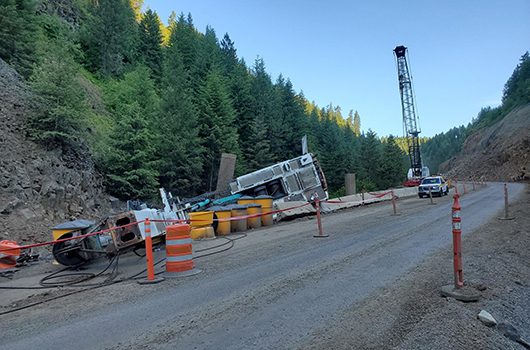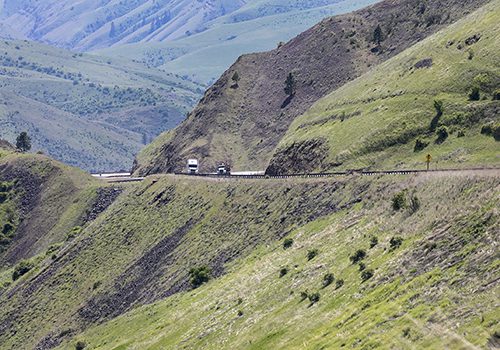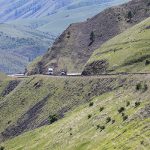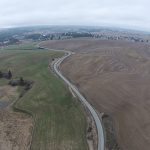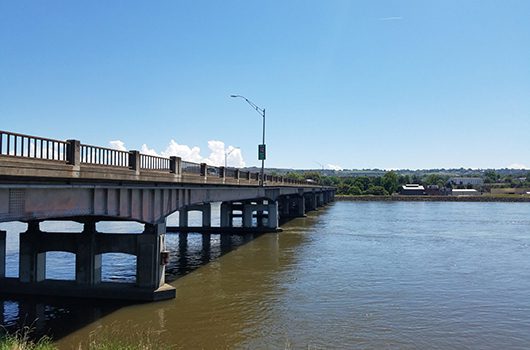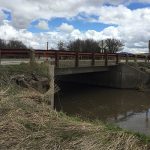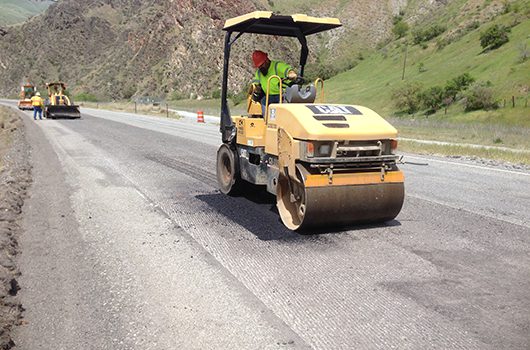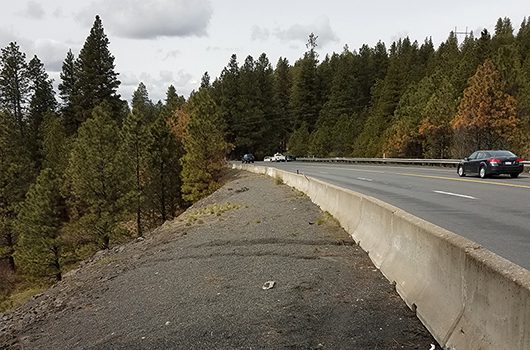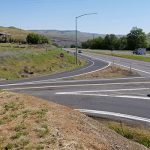Blasting and equipment removal are planned near ongoing work to add a passing lane in Culdesac Canyon on US-95, requiring intermittent, hours-long closures from 7 p.m. tonight to 4 a.m. tomorrow morning (July 2).
A blast is scheduled to start at 7 p.m., during which the road will be closed and not reopen until after debris is cleared, approximately 1.5 hours later.
Between 10 p.m. and 4 am, drivers can expect longer closures as crews remove a crane that fell Saturday afternoon onto US-95. Traffic will be allowed to pass around midnight, but between midnight and 4 a.m., drivers may not be able to pass through the area for up to three hours. No detours will be posted.
The crane fell while installing a temporary bridge. No one was injured during the incident, and crews were able to open US-95 to one lane later that afternoon.
Blasting operations are planned for the next two years in this area, with updates posted to 511.idaho.gov and displayed on message signs near the project. Traffic impacts are not expected July 3-5, though crews will be working in the area.
Resurfacing of White Bird Grade on US-95 is planned to start next week, with work beginning as early as Monday, June 24.
More than seven miles of the south side of the grade will be paved, with one lane open in each direction until construction is completed in August.
Work is expected during the day, with some weekend shifts possible. Paving is expected to start at the top of the grade and progress downhill.
Three runaway truck ramps will also be improved, requiring temporary closures. Larger vehicles will be notified at the top of the hill if any ramps are closed before descending.
Earlier this year, crews updated guardrail and signage in the area. More information on construction projects is available at itdprojects.org.
Starting next week, contractors will begin constructing temporary lanes for a project to replace a bridge and realign curves on one mile east of Potlatch on Idaho Highway 6.
Work will start near Gold Creek as crews build temporary lanes around the existing structure to be used during its replacement. These temporary lanes will be in place from late June until the bridge is completed in late October.
Once the temporary lanes are completed, crews will start moving dirt for realignment of the highway. Work will progress from town towards the bridge, with most earthwork occurring off the existing road.
Speed will be reduced during construction due to trucks entering and exiting the highway and the temporary alignment over Gold Creek. Flaggers will periodically reduce the highway to one lane. Two lanes will be open outside of work hours.
Work to widen a sharp curve in Potlatch will begin in early October. Drivers should expect only one lane with flaggers during the day and two lanes with gravel surfaces during non-working hours.
Construction is set to be complete by the end of October. Learn more at itdprojects.org/id6potlatchcurves.
The public is invited to an open house on Tuesday, June 11 to learn about plans to widen and repair the Clearwater Memorial Bridge.
The open house will be at the Red Lion Hotel (621 21st Street) from 4 p.m. to 7 p.m. Community members will have an opportunity to learn about the project, which is scheduled to start construction in 2023.
“The existing structure was built in 1951, and some of its components are nearing the end of their service life,” ITD project manager Curtis Arnzen said. “ITD is making major plans to improve the bridge to ensure that it will serve the region for many years into the future.”
Plans include widening the shoulders and sidewalks over the structure, as well as creating a wider median to divide lanes.
For more information and to comment online after the meeting, visit itdprojects.org/us12memorialbridge.
The Idaho Transportation Department has scheduled a series of tests in May and June near the Clearwater Memorial Bridge on US-12 in Lewiston. The tests will help develop plans to widen and repair the bridge, with work currently scheduled in 2023.
This weekend a hole will be drilled into the southeast corner of the bridge to examine soil quality, requiring the closure of the sidewalk.
Shortly after, river users will see a barge next to the bridge. From the barge crews will analyze the riverbed to help determine the best way to increase the bridge’s weight capacity. This testing will not affect recreational activities on the Clearwater River.
The existing structure was constructed in 1951, and some of its components are nearing the end of their service life.
“ITD is making major plans to improve the bridge to ensure that it will serve the region for many years into the future,” ITD project manager Curtis Arnzen said. “This project will improve the area’s safety, functionality and economic opportunity.”
An open house will be held in June to introduce the project and gather comments.
For more information, visit itdprojects.org/us12memorialbridge.
Picture of bridge at Little Hangman Creek.
Update as of May 21: Contractors now anticipate starting at Little Hangman Creek on Wednesday, May 29 and possibly starting at Butcher Creek in July.
Four bridges and three culverts from Grangeville to the Canadian border are scheduled for replacement over the next three years, beginning with Butcher Creek on Idaho Highway 13 near Grangeville.
Construction on Butcher Creek will start in late May and be completed around August, with the bridge reduced to one lane of alternating traffic.
Other structures scheduled for replacement this year include, in relative order, Little Hangman Creek on ID-60 near the Washington borer, Texas Creek on ID-11 near Weippe and Round Prairie Creek on US-95 near the Canadian border.
In 2020, ID-6 over Santa Creek near Michael Road, ID-3 over Cedar Creek near Clarkia and ID-57 over Kalispell Creek near Nordman will be reconstructed.
Each structure is expected to take two or three months with simultaneous work possible. In general, they will be reduced to one lane with alternating traffic controlled by flaggers or temporary signals.
All work is expected to be completed by spring 2021, with some work possible over the winter. T. La Riviere Equipment & Excavation, Inc. will replace the seven structures for $8.8 million.
Learn more by visiting itdprojects.org/d1d2bridges.
Work is ongoing to resurface 13 miles of US-95 north of the Time Zone Bridge. Construction began last week and is expected to wrap up in August.
The highway is reduced to one lane with alternating traffic controlled by flaggers. Drivers should expect up to 15-minute delays. Various pull outs on US-95 will be temporarily closed for a few hours at a time as the route is paved in the immediate area.
Contractors plan to work during weekdays, though some work at night and on the weekends may be necessary as construction continues.
During non-working hours and holidays, two lanes will be open. Learn more at itdprojects.org/us95goffto210.
Next week, contractors will start making improvements to US-95 in Moscow in advance of a large paving project this summer.
Beginning Monday, May 13, pedestrian facilities at Rodeo Drive and Pintail Lane will be brought up to current standards. Shoulder closures will be in place along with pedestrian and bicycle detours.
In early June, a section of road at the intersection of US-95 (South Washington Street) and East First Street will be resurfaced. Drivers can expect one lane open during the work. Pedestrian and bicycle detours will be in place as necessary.
As part of this project, Idaho Highway 66, from its intersection with US-95 to the Washington border, will be repaved in mid-June. Flaggers will be stationed at the intersection to guide traffic movements onto ID-66, which will be reduced to one lane.
In late June, contractors are scheduled to repave more than five miles between Rodeo Drive in Moscow and Four Mile Creek in Viola, including Moscow Mountain. During paving, US-95 will be reduced to one travel lane, with two lanes possible over the mountain.
Earlier work in May and July at Moscow Mountain will include installing a wall to help stabilize the hill, replacing the concrete guardrail on the west side and relocating a wildlife sensor. One lane will be closed for that work.
All work is expected to be completed by Poe Asphalt Paving, Inc. in late July for an estimated $2.3 million. Learn more at itdprojects.org/us95moscowtoviola.
This weekend, May 10-12, ITD operations crews will make changes to the right-turn lane into the east entrance of Aht’Wy Plaza to improve safety for turning drivers. These improvements will precede construction of the planned interchange.
Crews will sealcoat the turn lane on Friday to mask existing striping and will return over the weekend to sweep away any loose rocks. The turn lane is scheduled to be repainted on Monday, May 13. Drivers can expect the turn lane to be closed for a few hours each day while crews are on site.
The turn lane will be shifted to provide more separation from the through lanes of traffic, and the stop bar for exiting drivers will be moved closer to traffic to improve line of sight.
View a simple graphic of the planned change.
Modifications will prevent vehicles turning into the plaza from obscurring other vehicles passing through the area. A joint road safety audit with the Nez Perce Tribe in January determined that this blocking effect was a factor in recent fatal crashes.
To sign up for updates and learn more about coordinated safety efforts near the plaza, visit the project website at itdprojects.org/ahtwyinterchange.
Continued efforts by maintenance crews may allow US-12 between Greer and Kamiah to reopen tomorrow morning around 8 a.m.
“We are expecting some rain in the next day, but we are optimistic that there will be enough of a break in the weather to prevent more slides and allow us to reopen the road,” operations engineer Bob Schumacher said.
If there are no more slides, crews are on schedule to reopen the road, though there will be some restrictions. Drivers will be slowed to 35 mph for less than two miles near the worst slide area at milepost 63. That section of road is still covered by a thin layer of mud that could become slippery when wet.
Today crews continue to clear ditches, unclog culverts and haul material off the road. The highway will be monitored by maintenance forces over the weekend.
“Any time we have to close a road, we must find a balance between quickly reopening it and making sure it’s safe,” Schumacher said. “We thank drivers for their continued patience and hope to have the road open tomorrow.”
Motorists are advised to check for updates on 511.idaho.gov and to exercise caution while driving.
